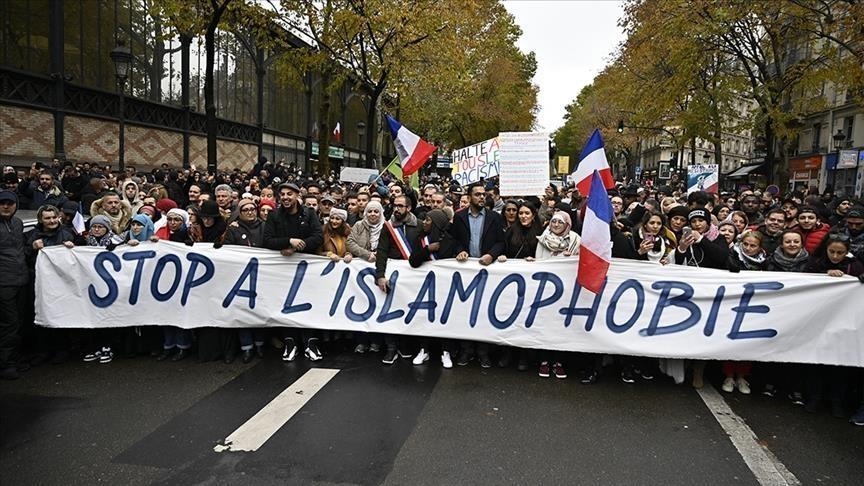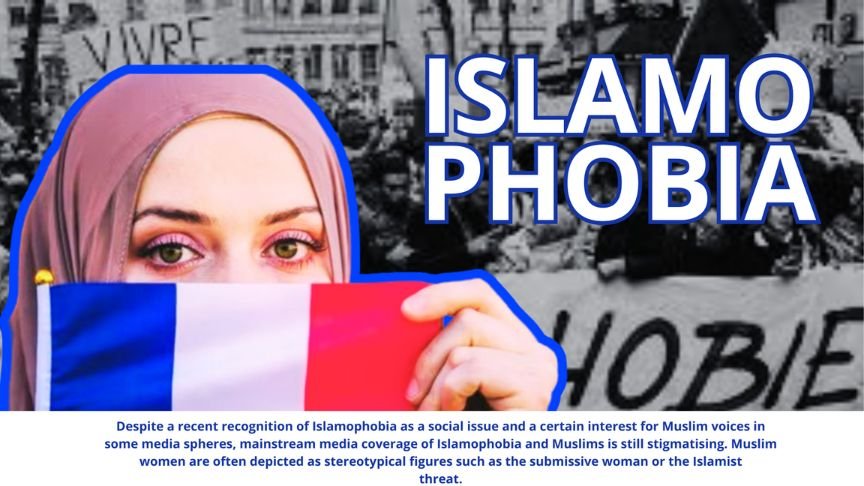Despite a recent recognition of Islamophobia as a social issue and a certain interest for Muslim voices in
some media spheres, mainstream media coverage of Islamophobia and Muslims is still stigmatising. Muslim women are often depicted as stereotypical figures such as the submissive woman or the Islamist
threat.
France has the largest Muslim community in Europe. While there were 44 million European Muslims in 2010 representing 6% of European’s total population, the French Muslim community accounted for 8% of the total population in france, or about 2.1 million people aged 18 to 50.
Estimations place the figure between 3.9 and 4.1 million Muslims in France with children and elderly included. Muslims form the second largest religious group in France after Christians.
In the political realm, the existence of Islamophobia is denied by a large number of political representatives
who contribute to the trivialisation and normalisation of Islamophobic discourse.
French public opinion on Muslims and especially on Muslim women is worrisome. According to some
opinion polls, the French Muslim community is the least tolerated population, with 53% of positive
responses (compared to 79.5% for the Jewish community) and only 26% of the French population having a positive image of Islam.
From a gender perspective, Muslim women are very negatively perceived: 79%
and 93% of the French population consider that wearing Islamic religious symbols, such as the headscarf
and full-face veil, constitutes a barrier to “co-existence” (“vivre-ensemble”)
In 2014, the CCIF recorded 764 Islamophobic acts, which is 10.6% more compared to 2013.8 On the
contrary, the National Observatory against Islamophobia (Observatoire national contre l’islamophobie)
registered a 41.1% decrease in of anti-Muslim acts between 2013 and 2014.
This difference can be explained by the methodology used by the two organisations. The Observatory’s data are based on those of the Ministry of Interior and only take into account the number of complaints concerning anti-Muslim actions and threats.
CCIF’s data also include the number of complaints and add cases of Islamophobia
reported to the organisation or released in the media. In its annual report for 2014, the Observatory admits
that the 2014 data “did not reflect reality as most Muslim victims do not report their cases to the police
nor do they file a complaint”.10 Since the Paris attacks in January 2015, the Observatory changed its
methodology and now includes data sent by the mosques’ network of the French Council of Muslim
Worship (Conseil Français du Culte Musulman, or CFCM,).
However, Islamophobic acts of have exploded over the last five years. 2015 foreshadows an unprecedented
increase. In the aftermath of the January 2015 terrorist attacks, more Islamophobic acts were registered in
one month than in a whole year (128 acts between 7 and 20 January 2015).11
Data on Islamophobia in France highlight a two-fold issue:
- Islamophobia is a predominantly institutionalised form of discrimination. In 2014, 71.6% of
Islamophobic acts were perpetrated by French institutions as opposed to private institutions or
individuals. One quarter of the total Islamophobic acts occurred in the field of education (primary
and secondary public schools).12 - Islamophobia tends to be a form of sexism that combines gender and religious discrimination. In
2014, 81.5% of Islamophobic acts and speech targeted women. Muslim women, and especially
Muslim veiled women (whatever the type of veil) because of their great visibility, account for
almost 100% of victims of physical aggressions.

Forgotten Women
Being a Muslim woman in France means being confronted with Islamophobic violence and discrimination
at every stage of life: at school, during educational and professional training, for administrative
procedures, at doctors’ offices, on the streets, in restaurants, at banks, at public swimming pools, etc.
In the employment field, discrimination occurs in vocational training, in access to employment, and in the
workplace as well
Employment field
In the French labour market, two common trends can be observed: women are in a more vulnerable
position than men, and, the majority population is more privileged than minority populations (be it
foreigners, immigrants and second-generation immigrants
As far as Muslim women’s situation in the French labour market is concerned, similar trends can be
noticed, revealing two types of gaps, on the grounds of gender and ethnicity:
- The gender gap: native women are less employed and equally affected by unemployment than
male foreigners (from all origins). This difference is confirmed and even more pronounced among
foreign women (from all origins): women from all origins are disadvantaged compared to men
(native or not) but also to non-immigrant women.14 - The ethnic gap: employment rates of immigrant women from Turkey, Algeria, Morocco, Tunisia
and Sub-Saharan Africa (who are mostly Muslims) are inferior to employment rates of immigrant
women from Southern Europe or the rest of the EU.
According to CCIF data, in 2014, 99 cases of religious discrimination were recorded in the fields of higher
education and vocational training (13% of the total acts of discrimination).16 In 2013, 18.6% of
Islamophobic acts occurred in the employment field. 7.35% of the discrimination cases took place in the
workplace and 11.25% of them were perpetrated by private companies, mainly in access to employment.
Among CCIF’s reported cases, a large majority of victims of discrimination in employment are Muslim
women, especially veiled women. Their headscarves often prove to be a barrier in accessing employment.
CV testings reveal three different trends as far as discrimination against Muslim women is at stake:
- The “intersectional effect”: The intersectional effect results in the creation of multiple
discrimination; gender and origin do not simply add upg. The crossed effects of gender and origin
create a double glass-ceiling effect for women of African descent. Discrimination on the basis of
gender and origin combines.18 - The “Muslim effect”: Within the same gender and ethnic intersectional categories, it is possible to
detect a “Muslim effect”. The candidate perceived as Christian received 2.5 times more positive
responses to her application than the candidate perceived as Muslim.
19 - The “headscarf effect”: Within the same gender, ethnic and religious intersectional categories,
wearing an Islamic religious symbol such as a headscarf reduces the chances of getting an interview
close to zero
Islamophobic Violence and Speech
As far as Islamophobic violence and speech are concerned, the CCIF recorded 103 cases of Islamophobic
discourse, 28 cases of verbal aggressions and 22 cases of physical aggressions in 2014. The Paris attacks of
January 2015 had a dramatic impact on Muslim women.
Reported cases of Islamophobic violence andspeech increased exponentially during the first quarter of 2015. CCIF monitoring registered more violence and insults within six months than in a whole year.
Between January and June 2015, physical and verbal aggressions respectively showed a 500% and 100% increase compared to the same period in 2014. Cases of Islamophobic discourse, 30 verbal aggressions and 32 physical aggressions were reported to the CCIF. Most victims are Muslim women, veiled women particularly.
Muslim women are therefore victims of multiple discrimination on the grounds of gender, religion and
ethnicity.
Wearing a headscarf clearly constitutes an additional barrier when it comes to entering the
French labour market or facing verbal and physical violence.


7v4qok